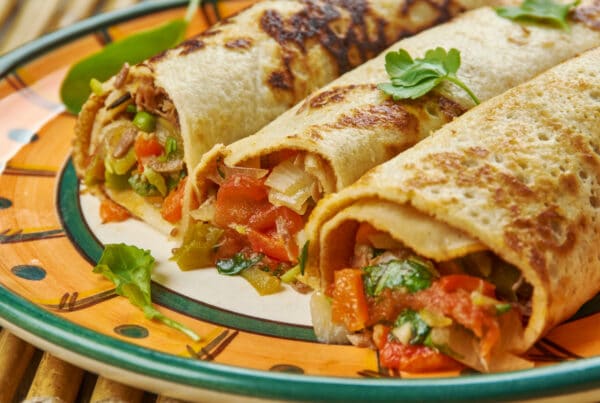Below you will find a quick list of foods to eat and foods to avoid, based on the Chinese Medicine diet. After the “quick list” you will find more information explaining why certain foods are recommended and why others are to be avoided. Alternative food choices and food substitutes are recommended and the importance of eating organic, non genetically modified (GMO) foods.
Vegetables
- All types in large quantity
- Aim for half your plate in veggies
- Limit nightshades such as eggplant, tomato, potato, peppers as they are inflammatory for some people
Starches
- White or Brown Rice
- Rice Cakes, Gluten Free Crackers
- Quinoa, Millet or other Non-Glutinous Grains
- Yams, Sweet Potato
- Winter Squash
Gluten free breads and crackers with whole food ingredients are the best choices. If you are opting for wheat, sprouted wheat bread is preferred over bread made from wheat flour. Choose simple grain ingredients such as just sprouted wheat over the multi-grain products, since these can exacerbate food allergies. There are even gluten free wraps available!
Animal Protein
- Free Range Eggs
- Organic Meats
- Wild Caught Fish
Vegetable Protein
- Beans – fresh or canned
- Legumes such as Lentils, Split Peas
Seasonal Fruits
- Apples and pears in the fall
- Berries and melons in the summer
Fats
- Raw Nuts & Seeds
- Raw Nut or Seed Butter
- Extra Virgin Olive Oil or Cold Pressed Vegetable Oils
- Extra Virgin Coconut Oil for cooking
- Ghee – clarified butter (contains no casein which is an allergen in milk)
Beverages
- Herbal Tea
- Green Tea, Black Tea, Coffee, Yerba Mate
- Room Temperature Water
Dairy Substitutes
- Rice Milk
- Hemp Milk
- Almond Milk
- Oat Milk
Soup/Stew
All types of vegetables, whole grains, meat or beans, and stock.
Foods To Avoid
- Excess flour products
- Dairy
- Sugar
- Tropical Fruits
- Processed Food
- Frozen meals
- Greasy food
- Processed Fats
Beans & Vegetarianism
Beans and legumes are 1/2 to 1 cup servings and can be eaten more freely as they absorb cholesterol and toxins, are high in fiber and are nutrient rich. Smaller beans are easiest to digest and adding a small amount of seaweed can help. If you don’t like seaweed, you can opt for digestive enzymes if beans give you digestive problems.
Soy is not recommended as it is often genetically modified, increases estrogen in the body, and is difficult to digest in general. Fermented soy is a good choice as the fermentation process pre-digests the soy making it easier on your body. Miso is a fermented soy product used for soups and broths. Some people enjoy a fermented soy product called Natto. Natto is a Japanese food containing nattokinase which is good for thinning the blood. Tofu is fine if you can digest it but is a COLD food so limit your intake to the warmer months and avoid tofu in the winter.
Chinese Medicine does not recommend total vegetarianism. In traditional medicine, animal protein a few times per week keeps the blood well nourished. In Chinese medicine, your blood is the basis of energy production called ‘qi’. When qi and blood are depleted, fatigue, chronic illness, and problems with fertility are common issues that can develop.
Why No Dairy?
A very building, mucus forming food, dairy is a major culprit in allergies and asthma. It not only clogs the airways with phlegm but also blocks the channels that we use in acupuncture to balance your energy. If it clogs subtle energy channels, imagine what it is doing to the rest of your body! Cow’s milk is meant to grow a baby calf into a bigger version of itself. Once it is big enough, it naturally stops nursing from its mother. Dairy is the lactation product of a different species. It seems unnatural for humans to ‘nurse’ cross species. As adults, we would think it quite abnormal to drink breast milk past the time we are babies so why should we drink the milk of a lactating animal?
Dairy food is considered overly nourishing to be fed to those who are malnourished or emaciated. If you are a full-grown, well fed adult, dairy further ‘builds you’ resulting in accumulation of mucus and excess fat.
Although yogurt has been touted as a health food for its pro-biotic benefits, you can get probiotics in pill form instead. Additionally, there are several non dairy yogurts on the market to choose from.
If you do choose to have dairy, raw dairy products are recommended since cooked dairy loses valuable elements that make it digestible. If you think about it, our ancestors consumed their milk products raw for thousands of years. Pasteurization wasn’t discovered until 1864. If raw dairy was so dangerous, it would have killed our ancestors and none of us would be here today! Animals that are well cared for produce healthy milk that is safe to consume raw and is available in our area from reputable farms.
What About Calcium?
Calcium is abundant in vegetables, nuts, seeds, and fish. One cup of broccoli has more than 50% of the calcium contained in one cup of milk. A six ounce serving of salmon or sardines is equivalent to the calcium content of one cup of milk. One cup of cooked collard greens or spinach are also equal to the calcium in a cup of milk. If you are eating half your plate in vegetables and including leafy greens, you will ingest plenty of calcium. Better yet, the calcium in vegetables is more easily absorbed and occurs in proper ratios to other minerals that are important for bone health. Vitamin D is essential to help you absorb more calcium. Sun exposure in warm weather is the best way to produce vitamin D, though not always practical. Rich food sources of vitamin D include eggs and fattier fish like salmon. Vitamin D supplementation along with K2 is recommended for those who do not get enough sun exposure.
Why Organic?
Organic foods are grown in good quality soil resulting in nutrient dense food with abundant life force. Commercially grown produce is often grown in nutrient poor soil that must be chemically fertilized and sprayed with pesticides. It is usually picked unripe to prolong shelf life. Because it is picked before it is ripe, commercial produce is often gassed before sale to facilitate ripeness.
Pesticides found on commercial produce kill bugs by interfering with the bug’s nervous system. By disrupting communication between the bug’s nerves and muscles, the bug becomes paralyzed and dies. Pesticides can accumulate in our fat cells over time and have been associated with neurological diseases in humans. They are implicated in certain cancers, including cancer of the prostate. Additionally, chemical fertilizers, pesticides, fungicides, and herbicides found in commercial foods create more free circulating estrogen resulting in ‘estrogen dominance’. Estrogen dominance is associated with reproductive cancers and excess female characteristics in men.
Commercial produce grown in depleted soil is created to look good but often lacks taste due to its poor nutrient density. Organic foods grown in rich soil usually appear smaller but are nutrient dense so you get more nourishment for your money. Eating nutrient dense food provides you with high quality nutrition, potentially eliminating food cravings because your body’s vitamin and mineral requirements are being met.
Hormone & Antibiotic Free Animal Protein
Grass fed beef is naturally raised without the use of antibiotics or growth hormones. It is higher in good fats such as omega 3’s with less of the harmful omega 6 type fats. Wild caught salmon and other types of fish are caught in the ocean rather than raised in crowded conditions and fed unnatural feed. Free range eggs are laid by chickens that have room to roam rather than penned in cramped, artificially lit, airless cubicles. The resulting food products of animals raised in humane, natural environments are superior in nutrition to their commercially raised counterparts.
Why Non GMO and Hormone Free?
Genetic modification is used to create bigger, more pest resistant produce and to enable weed killer to be sprayed onto crops without killing the plant. Factory farmed animals are usually fed GMO containing feed. Hormones are routinely given to factory farmed animals to force them to grow quickly. The commercial dairy industry gives a hormone to cows called rBST or rBGH in order to increase their milk production. Dairy cows given this hormone suffer serious side effects including greatly shortened life spans. If you are still using dairy, look for a label that says free of rBST or rBGH.
Some countries outside of the United States have labeling laws that require disclosure when food has been genetically modified. Here, our labeling laws can be obscure, with words such as bioengineered or QR codes that you need to scan. The best way to ensure you are not eating genetically modified foods are to look for the label with the butterfly and ‘Non GMO Project’ on the package.
Seasonal Eating
Eating according to the seasons will help balance your body. A balanced body processes foods efficiently and slows down the disease process.
Winter – soups, stews, baked yams, winter squash, well cooked whole grains, firmer, thicker vegetables, larger beans, more chicken (very warming), beef, lamb, very little fish (cooling). No raw or cold food!
Spring – spring greens, sprouts, more lightly cooked veggies, mung beans, lighter whole grains, beef, begin adding fish (cooling). Less nuts this time of year.
Summer – small amounts of raw, lighter veggies, short cooking times, very light whole grains, smaller, easier to digest beans, more fish, less read meats, even less chicken (very warming). Berries in season. Avoid greasy, overly spicy this time of year.
Fall – less raw, more cooked veggies, sturdier grains, less fish, more read meats, apples and pears in season. Avoid drying, pungent flavors like ginger and garlic.
Quality vs. Cost
Quality is a top priority when choosing whole foods to include in your balanced diet. You will pay more money for better quality. However, you will be eating more whole fresh foods which are cheaper overall than processed, frozen, conveniently packaged foods.
One way to defer the cost is to ditch the vitamin supplements and choose organic whole foods instead. You could also forego dinner at restaurants and transfer the cost of an expensive dining experience to the healthy food you want to eat every day. Your health is worth every penny.




So glad I found this my daughter who is 2 has severe allergies and I have raised her being so mindful of her diet and now looking into TCM and treatment through this route starting with chinese medicine diet This page makes everything so clear and explains in so much detail thank you 😊
Thank you for all the great information. You have laid out the information in a very clear way. It is so hard to change the way we have been taught to eat culturally in the US South. Of course, I know some of information but a review is always good. Much appreciated.